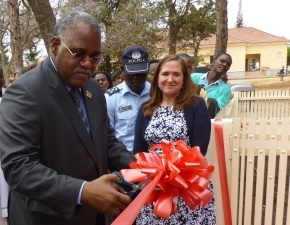
Minister of Health Dr. Serra Van-Dunem, cuts the ribbon at the launch of the first insectary in Angola. Dr. Teresa McGhie, USAID/Angola mission director, and other supporters look on.
Insecticide-treated bed nets and indoor residual spraying are common malaria prevention techniques. But how do we know they’re working? Does the insecticide in bed nets and sprayed on walls kill mosquitoes that transmit malaria? How long does insecticide last?
To answer these questions entomologists need a laboratory, microscopes, and other equipment to study mosquito behavior. Such a facility was previously not available in the low-resource setting of rural Angola. Entomologists were working out of a make-shift laboratory in an office basement. But, in September 2013, the Abt-led Africa Indoor Residual Spraying project (AIRS) with funding from the President’s Malaria Initiative opened the doors of the country’s first laboratory for studying mosquitoes, called an insectary, in Huambo.
AIRS Angola staff were inspired by a new mobile insectary model developed by AIRS Mali. Using the insectary-in-a-box model, AIRS Angola converted a 8×40 foot shipping container into a functioning insectary. The shipping container was refurbished and separated into several rooms with temperature controls to make rooms ideal for breeding or rearing susceptible colonies of mosquitoes to use for entomological testing.
“The insectary-in-a-box was an innovation. It was inexpensive to create and could be built in only one month,” said Lourdes Loch, AIRS Angola chief of party.
The new insectary is located on government property at the Huambo district hospital. Huambo is one of three provinces where AIRS is implementing IRS and one of the most malarious provinces in Angola. Provincial Directorate of Health of Huambo, Dr. Carlos Frederico Juliana played a key role in making government property available for the insectary.
In addition to building the laboratory, AIRS provided on the job training for one project and one government entomologist. Vicente Chipepa is a staff member of the Provincial Directorate Health of Huambo who has been working in partnership with the AIRS project since February 2013. He attended three entomology trainings led by Abt and the Centers of Disease Control and Prevention.
“I am applying my skills and putting them to practice in the field daily,” said Chipepa.
Several government health officials including the Minister of Health, Dr. Serra Van-Dunem, and the Provincial Directorate of Health of Huambo, Dr. Juliana, attended the September 26, 2013 insectary launch event.
Malaria accounts for an estimated 35% of mortality in children under the age of five, 25% of maternal mortality. Last year, AIRS sprayed 141,782 structures protecting a total of 676,090 people from malaria in the Huambo, Huila, and Cunene provinces of Angola. With innovations such as the insectary-in-a-box and entomological training to build the capacity of local scientists, AIRS Angola and government partners can generate better quality data to ensure IRS protects people from malaria.
